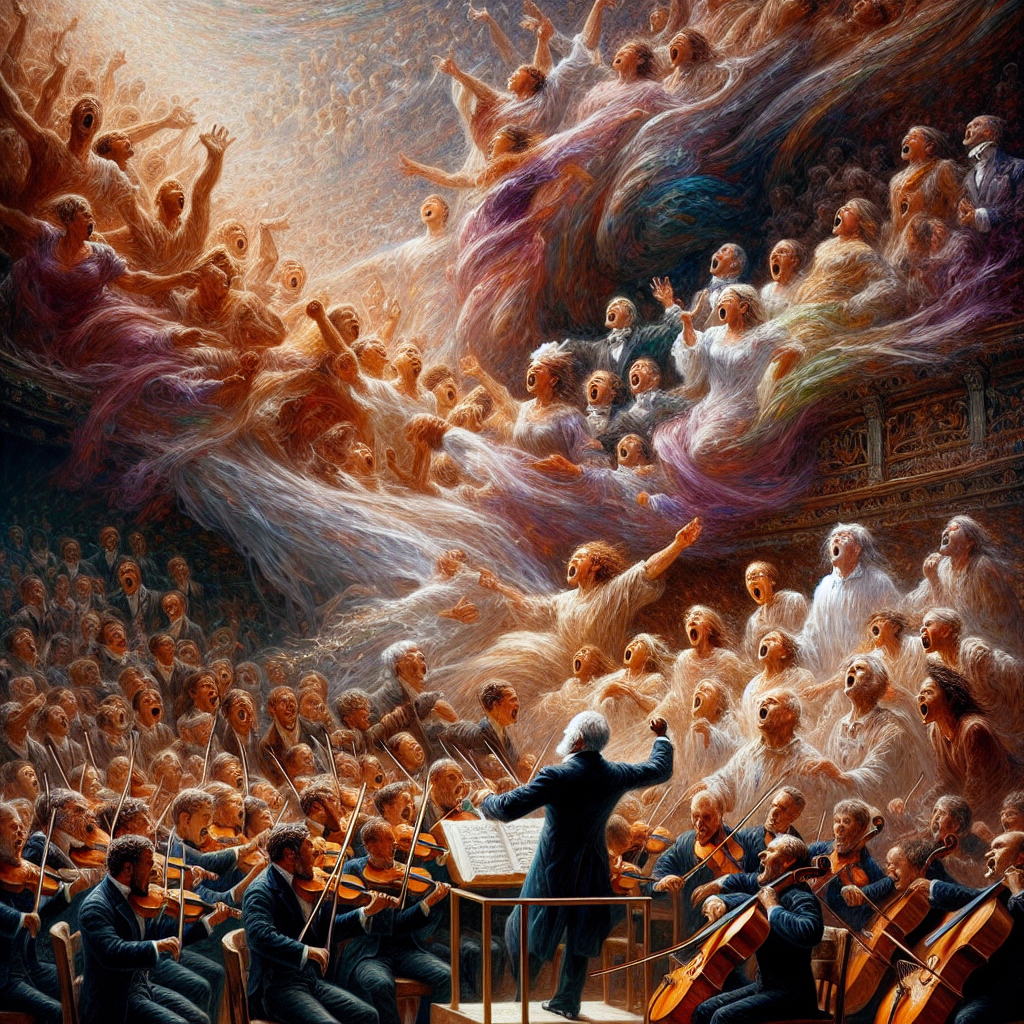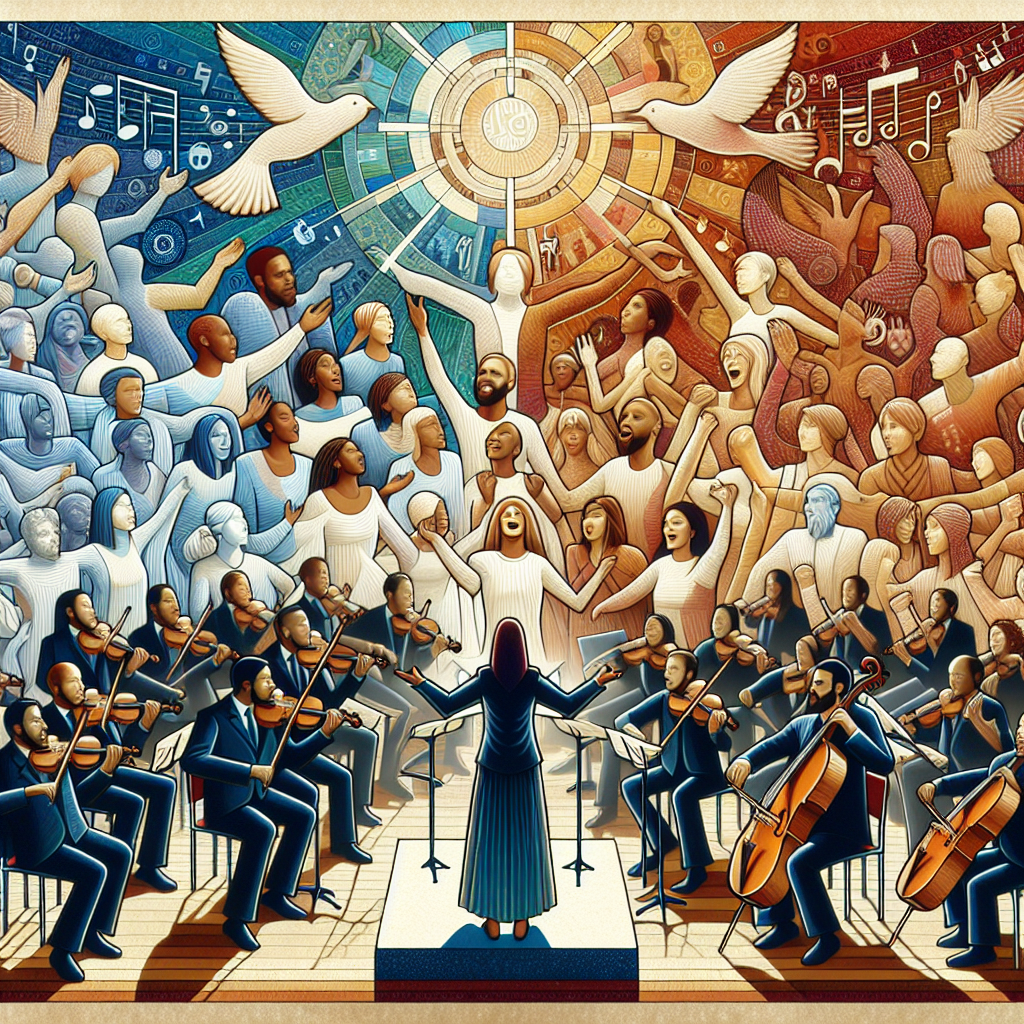
The Ninth Symphony’s Choral Finale – An Ode to Joy and Brotherhood
Ludwig van Beethoven, a towering figure in classical music, is renowned for his extensive and influential contribution to the world of music. Born in Bonn, Germany, in 1770, Beethoven’s musical prowess became apparent at a young age. Despite facing immense personal challenges, including profound hearing loss, he composed some of the most iconic works in classical music. Among his vast repertoire, one piece stands out not only for its musical brilliance but also for its philosophical and cultural significance—his Ninth Symphony, famously known for its choral finale “Ode to Joy.”
The Ninth Symphony, completed in 1824, was Beethoven’s final symphony—a monumental work that broke new ground by incorporating vocal soloists and a chorus, which was unprecedented in symphonic music at the time. The choral finale, set to Friedrich Schiller’s poem “Ode to Joy,” is a powerful ode to humanity, unity, and brotherhood. The inclusion of vocal elements in a symphony was Beethoven’s bold statement, reflecting his vision of music as a universal language capable of conveying profound messages.
This article delves into the details of Beethoven’s life, the circumstances surrounding the creation of his Ninth Symphony, the innovative aspects of the choral finale, and its lasting impact on music and society. We will explore how “Ode to Joy” has transcended its origins to become an anthem for global peace and unity, and how Beethoven’s legacy continues to inspire musicians and audiences around the world.
Early Life and Career
Ludwig van Beethoven was born into a musical family; his grandfather was a court musician, and his father was a singer who recognized Ludwig’s talent early on. Beethoven’s initial music education was rigorous, often harsh, as his father aimed to mold him into a prodigious performer like Mozart. This early training paid off, and by the age of 12, Beethoven was already composing, showing remarkable skill and innovation.
Beethoven’s move to Vienna in his early 20s marked a significant turning point in his career. Vienna, the musical capital of Europe, offered him opportunities to study under renowned composers such as Joseph Haydn. Beethoven quickly gained a reputation as a virtuoso pianist and an innovative composer, pushing the boundaries of classical music. His early works, including his first and second symphonies, were well-received and showcased his unique style.
However, Beethoven’s life was not without struggle. He began to lose his hearing in his late twenties, a devastating blow for a musician. Despite this, he continued to compose, driven by an unwavering passion for music. His middle period, often referred to as his “heroic” phase, produced some of his most admired works, including his Third Symphony (Eroica) and his Piano Concerto No. 5 (Emperor). These compositions reflected his battle with personal adversity and his resilience.
The Making of the Ninth Symphony
Beethoven’s Ninth Symphony was composed during the final phase of his career, a period marked by profound introspection and groundbreaking creativity. By this time, his deafness had progressed significantly, isolating him from public concerts where he could no longer perform his works. Undeterred, Beethoven poured his emotions and philosophical inquiries into his compositions, creating music that transcended his personal struggles.
The Ninth Symphony was conceived over many years, with Beethoven revisiting and refining his ideas. He had long desired to set Schiller’s “Ode to Joy” to music, seeing the poem’s themes of universal brotherhood and joy as aligning perfectly with his own ideals. The inclusion of a choral finale in a symphony was a revolutionary concept, reflecting Beethoven’s innovative spirit and his vision that music could convey complex human experiences and aspirations.
The premiere of the Ninth Symphony in Vienna on May 7, 1824, was a historic event. Although Beethoven was completely deaf by this time, he insisted on conducting the performance himself. It is famously reported that he was unable to hear the applause and had to be turned around to see the audience’s enthusiastic response. The performance was a triumph, affirming Beethoven’s place as one of the greatest composers in history.

Innovative Aspects of the Choral Finale
The choral finale of Beethoven’s Ninth Symphony is a landmark in the history of Western music. Before Beethoven, symphonic works were purely instrumental. By integrating vocal soloists and a chorus, Beethoven expanded the expressive range of the symphony and opened new possibilities for future composers.
The finale begins with a powerful orchestral introduction, leading into the famous “Ode to Joy” theme played initially by the cellos and double basses. This melody, simple yet profoundly moving, evolves through various orchestral treatments before the entrance of the vocal soloists and chorus. The lyrics, drawn from Schiller’s poem, extol the virtues of joy, friendship, and unity among all people.
Beethoven’s innovative use of form and structure in the choral finale was groundbreaking. He employed a theme and variations format, interspersing choral sections with instrumental passages, creating a dynamic and dramatic progression that culminates in an exuberant celebration of joy. The blending of orchestral and vocal elements was masterfully executed, demonstrating Beethoven’s genius in creating complex, multi-layered compositions.
The Cultural Impact of “Ode to Joy”
Since its premiere, the choral finale of Beethoven’s Ninth Symphony has had a profound cultural impact. “Ode to Joy” has been embraced as an anthem of unity and peace, transcending its original context to become a symbol of hope and brotherhood across the globe. Its universal message has resonated with audiences worldwide, making it one of the most performed and recorded pieces of classical music.
In the 20th and 21st centuries, “Ode to Joy” has been associated with significant historical and cultural events. It was performed during the fall of the Berlin Wall in 1989, symbolizing the triumph of freedom and the reunification of Germany. The European Union adopted its melody as the anthem of Europe, representing the ideals of unity and solidarity among its member states.
The universal appeal of “Ode to Joy” is a testament to Beethoven’s ability to capture the essence of the human spirit through music. Its themes of joy, friendship, and the shared humanity resonate as strongly today as they did when they were first composed. As a result, “Ode to Joy” continues to inspire and uplift people from all cultures, reinforcing the enduring power of Beethoven’s music.
Beethoven’s Legacy
Ludwig van Beethoven’s influence on the world of music cannot be overstated. His works, characterized by their emotional depth, structural innovation, and expressive power, have left a lasting imprint on the repertoire of classical music. The Ninth Symphony, with its choral finale, remains one of his most celebrated and enduring achievements.
Beethoven’s legacy extends beyond his compositions. His life story, marked by personal hardships and triumphs, has inspired countless musicians, artists, and thinkers. His determination to pursue his artistic vision despite his deafness serves as a powerful reminder of the resilience of the human spirit.
The Ninth Symphony’s choral finale continues to be performed and celebrated around the world. Its message of joy and brotherhood speaks to people of all ages and backgrounds, reinforcing the idea that music can bridge cultural divides and bring people together. Beethoven’s vision of a universal language of music that transcends individual differences remains as relevant today as it was in his time.
Conclusion
The Ninth Symphony and its choral finale “Ode to Joy” stand as a testament to Beethoven’s genius and his belief in the transformative power of music. Through this monumental work, Beethoven not only expanded the boundaries of symphonic music but also conveyed a timeless message of unity, joy, and brotherhood. The innovative integration of vocal elements into a symphony was a bold move that opened new horizons for future composers and left an indelible mark on the history of music.
Beethoven’s Ninth Symphony is more than just a piece of music; it is a cultural artifact that continues to inspire and unite people across the globe. Its themes of shared humanity and the pursuit of joy resonate deeply with audiences, reflecting Beethoven’s enduring impact on the world.
As we celebrate the life and legacy of Ludwig van Beethoven, it is important to recognize the profound influence his works have had on music and society. The Ninth Symphony’s choral finale remains a beacon of hope and a symbol of the enduring human spirit. Beethoven’s music, characterized by its emotional depth and innovative genius, continues to captivate and inspire, ensuring his place as one of the greatest composers in history.
The legacy of the Ninth Symphony and its iconic “Ode to Joy” will undoubtedly endure for generations to come, reminding us of the power of music to inspire, unite, and uplift the human soul. As we listen to the soaring melodies and powerful harmonies of Beethoven’s masterpiece, we are reminded of the universal language of music and its ability to bring people together in a shared celebration of life and humanity.